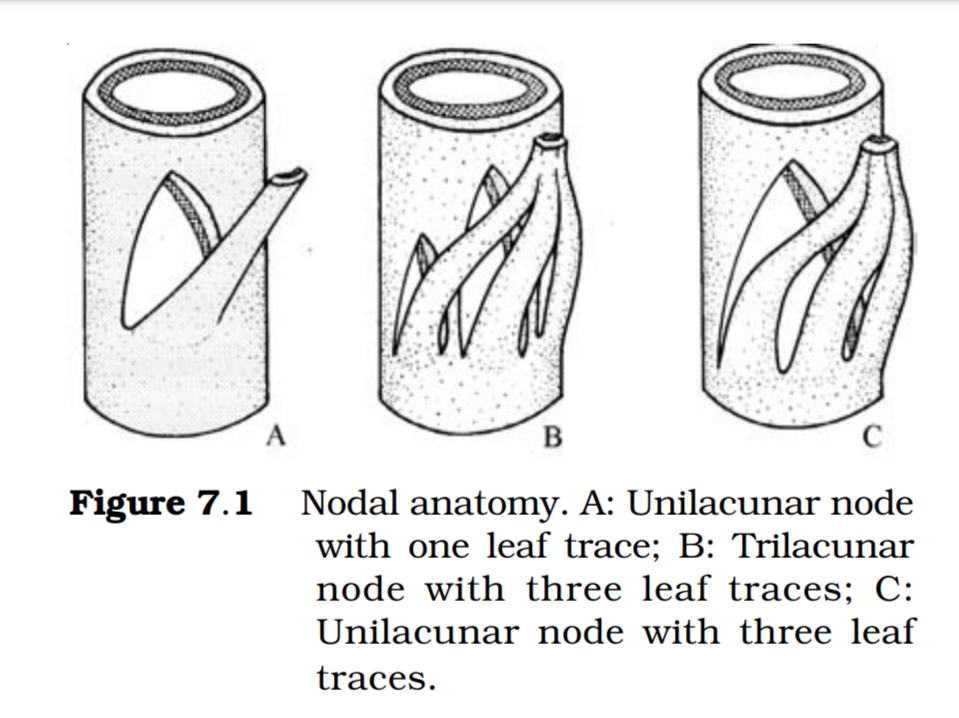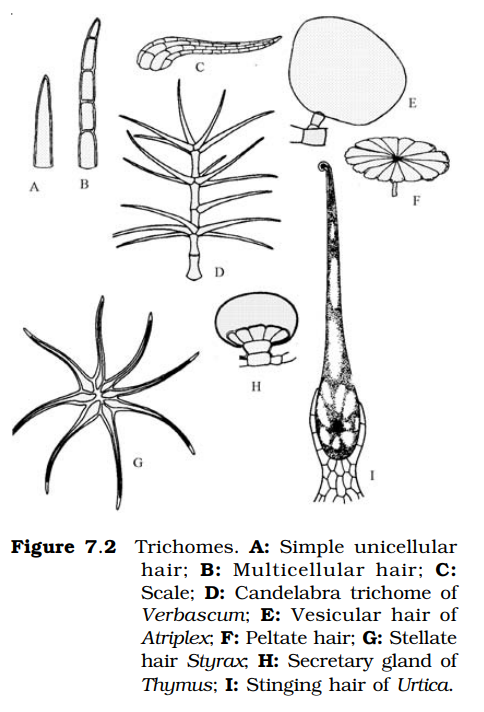Role of Anatomy in Taxonomy

Anatomy is one of the significant branches of biology which act as the backbone of taxonomy. In this article Role of Anatomy in Taxonomy we will see the study of anatomical details of flowering plants has a long history of its own. The discovery of various modern techniques and vast improvements in tools, especially the invention of microscopes have certainly added a lot to the finer detail of plant tissues. Mention may be made of some excellent works of Engler (1893-1896), and Solereder (1899) in Systematische Anatomic der Dicotyledoneae, which emphasises the significance of xylem structure in taxonomic procedures.
ANATOMY: Role of Anatomy in Taxonomy
Anatomical characters have played a highly significant role in the explanation of phylogenetic relationships. Anatomical features are analysed with the help of a light microscope; whereas ultrastructure (delicate details of contents) and micromorphology (smaller details of surface features) are brought out using an electron microscope. Bailey and his students mostly did anatomical work of taxonomic significance. Carlquist (1996) has given the trends of xylem evolution, specifically in the case of primitive angiosperms.
Wood anatomy: Role of Anatomy in Taxonomy
In order to understand the role of Anatomy in Taxonomy, one must consider the wood anatomy as crucial context.
Wood represents secondary xylem comprising the bulk of trees and shrubs, formed through the activity of vascular cambium. It primarily consists of tracheids and vessels. Tracheids are long narrow elements with tapering ends, imperforate at ends, and transfer of water and minerals occurring through pit pairs (two adjacent pits of two tracheids, separated by primary cell walls).
The vessels, on the other side, consist of vessel elements, extra broader than tracheids and with perforation plates at ends (with an opening not having primary walls unlike pit-pair). Vessel elements are joined end to end to form long tubes, the vessels. The perforation plate may be simple with a single opening or compound with several openings. Latter with elongated openings in a row like a ladder is known as scalariform, a common type in primitive angiosperms.

Nodal anatomy has considerable significance in angiosperm systematics. The number of vascular traces entering the leaf base and
associated gaps (lacunae) left in the vascular cylinder of the stem at each node is distinctive for several groups. The node may have a single gap (unilacunar) from a single leaf trace or three leaf traces (two additional commonly entering stipules) or three gaps (trilacunar) associated with three leaf traces. The genus Illicium has been separated from Winteraceae because of unilacunar nodes, continuous pseudosiphonostele and the absence of granular material in stomatal depressions.
Trichomes
Trichomes constitute appendages of the epidermis which may be non-glandular or glandular. Non-glandular trichomes may be in the form of simple unicellular or multicellular hairs (common in Brassicaceae, Lauraceae and Moraceae), in the form of vesicles, peltate hairs (Olea) or flattened scales.

Branched hairs may be dendroid, stellate (Styrax) or candelabrum-like (Verbascum). Glandular trichomes may be sessile or stalked and present a variety of forms. Unicellular glandular hairs of the Atriplex are bladder-like with few-celled stalk and basal cells and they secrete salt. Others may secrete nectar (calyx of Abutilon), and mucilage (leaf base of Rheum and Rumex).
The stinging hairs of Urtica are highly specialized with silica tip which readily breaks when hair is touched. The broken tip is sharp like a syringe and easily penetrates the skin injecting irritating cell contents. Trichomes hold considerable promise in the systematics of angiosperms. Trichomes have been of considerable help in Cruciferae (Schulz, 1936), especially in the genera
Epidermal features:
Epidermal features are also of considerable taxonomic interest (SEM epidermal features are discussed under ultrastructure and micromorphology). Prat (1960) demonstrated that one can distinguish a Festucoid type (simple silica cells, no bicellular hairs) and Panicoid type (complicated silica cells, bicellular hairs) of the epidermis in grasses.
Stomatal types are distinctive of certain families such as Ranunculaceae (anomocytic), Brassicaceae (anisocytic), Caryophyllaceae (diacytic), Rubiaceae (paracytic), and Poaceae (graminaceous).Anomocytic type has ordinary epidermal surrounding the stomata. In others, the epidermal cells surrounding the stomata are differentiated as subsidiary cells. There may be two subsidiary cells at right angles to the guard cells (diacytic), two more parallel to the guard cells (paracytic), or three subsidiary cells of unequal size (anisocytosis).

Other types include actinocytic type with stomata surrounded by a ring of radiating cells, cycloptic with more than one concentric ring of subsidiary cells and tetracytic with four subsidiary cells. The stomatal complex of Poaceae is distinctive in having two dumbbell-shaped guard cells with two small subsidiary cells parallel to the guard cells.
Leaf anatomy: Role of Anatomy in Taxonomy
The florets of Poaceae are reduced and do not offer much structural variability. Leaf anatomy has been of exceptional taxonomic help in this family. The occurrence of the C-4 pathway and its association with Kranz anatomy (dense thick-walled chlorenchymatous bundle sheath, mesophyll simple), has resulted in a revised classification of several genera of grasses. Melville (1962, 1983) developed his gonophyll theory largely on the basis of the study of venation pattern of
leaves and floral parts.
The rejection of Sanmiguelia and Furcula as angiosperm fossils from the Triassic has largely been on the basis of a detailed study of the venation pattern of leaves (Hickey and Doyle, 1977). The more recent rediscovery of Sanmiguelia from the Upper Triassic of Texas (Cornet 1986, 1989) points to presumed angiosperm incorporating features of both monocots and dicots. The discovery of the Late Triassic Pannaulika (Cornet) from the Virginia-North Carolina border has reopened the possibilities of the Triassic origin of angiosperms.
Floral anatomy: Role of Anatomy in Taxonomy
Floral anatomy has been one of the thoroughly explored areas, with significant contributions
to the understanding of Role of Anatomy in Taxonomy and phylogeny of angiosperms. Vascular traces in the carpels of various genera of the family Ranunculaceae have confirmed the origin of achene (Ranunculus, Thalictrum, etc.) from follicles (Delphinium, Aquilegia, etc.) through successive reductions in the number of ovules ultimately to one. The additional traces which would have gone to other ovules, now aborted, can be observed in many genera.
There, thus, is no justification for Hutchinson’s separation of achene bearing genera and follicle-bearing genera into separate families Ranunculaceae and
Helleboraceae, respectively. Melville (1962, 1983) developed his gonophyll theory after studying the vasculature
of the carpel and other floral parts through the clearing technique. He believed the angiosperm carpel to be a modified dichotomous fertile branch adnate to the petiole of a leaf. Sporne (1971) cautioned against such a drastic conclusion citing the example of bathroom loofah.
The genus Melandrium was segregated from Silene on the basis of the ovary being unilocular as against partly septate in Silene. Detailed floral anatomy revealed that in all the species of both genera, the ovary is multilocular, at least in the early stages of development. The septa break down to various degrees in different species as the ovary develops. Thus structurally, the ovaries are similar. The two genera were consequently merged into the single genus Silene.
The inferior ovary in angiosperms has been formed in two ways: appendicular origin (formed by fusion of calyx, corolla and their traces to the ovary wall; in this case, all vascular traces have normal orientation, i.e. phloem towards the outside) or by axial invagination (formed by depression of the
thalamus; the inner vascular traces have reverse orientation, i.e. phloem towards the inside).
Studies on floral anatomy have confirmed that the inferior ovary is of appendicular origin in a large majority of families. Only in a few cases (Rosa, Cactaceae, etc.) is the origin by axial invagination of the thalamus.
Comment below if you like the blog Role of Anatomy in Taxonomy and if this blog helped you, it means a lot and will give us the energy to work with the same enthusiasm in future! This is it for today. See you in the Next article, Thank you!
You will also like :
Download Free Book of Plant Physiology by Taiz and Zieger 6th edition
[Download] Plant Systematics by Gurcharan Singh PDF Book 3rd edition
If you want important notes and updates about exams on your mobile then you can join SACHIN’SBIOLOGY on Instagram or Facebook and can directly talk to the founder of Sachin’s Biology and Author of biologywala.com Mr Sachin Chavan M.Sc. NET JRF (AIR 21) GATE, MH-SET


![[PDF] Embryology in Relation to Angiosperms Taxonomy | 7 Role of Embryology in Taxonomy 7 [PDF] Embryology in Relation to Angiosperms Taxonomy | Role of Embryology in Taxonomy](https://biologywala.com/wp-content/uploads/2023/08/Embryology-in-Relation-to-Taxonomy-in-Angiosperms-520x245.webp)